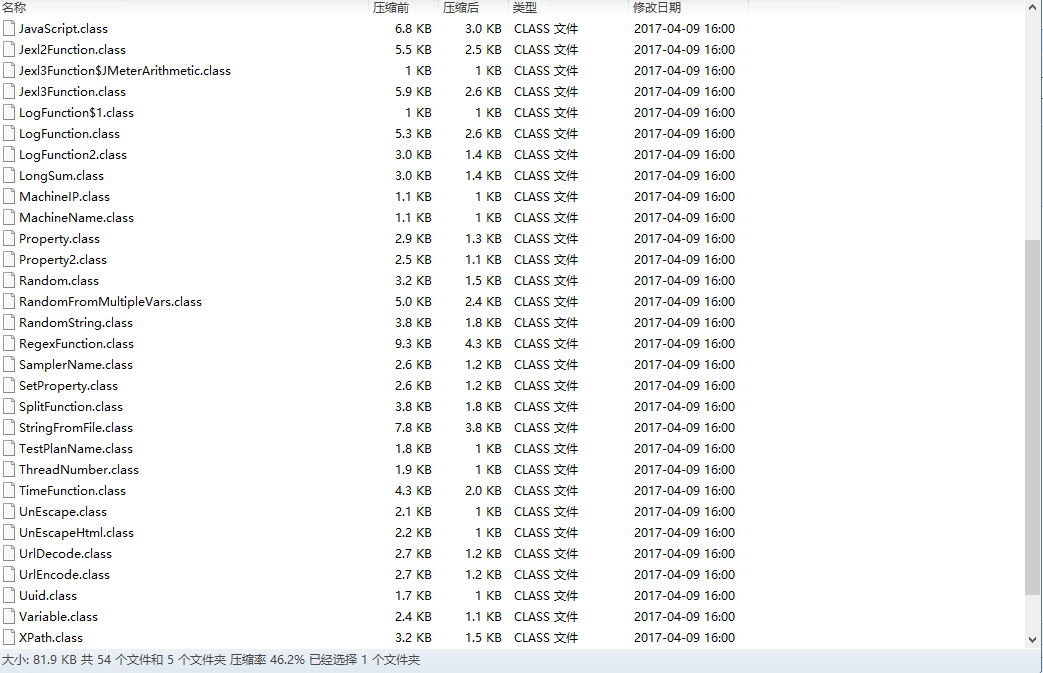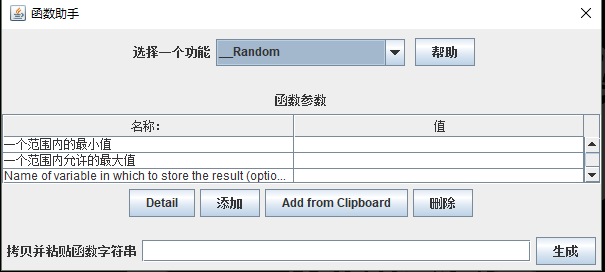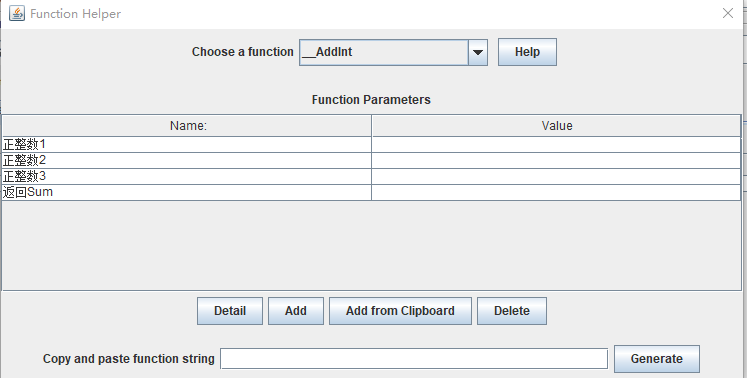“技术是业务的支撑”,已经不是第一次听到这句话,因为有各种各样的需求,因此衍生了许多各种各样的技术。共勉!
前面有提到提到过Jmeter的安装目录结构,也提到Jmeter的常用函数功能,有部分工作使用函数便可以完成,有满足,那肯定是有不满足的,本篇来记录函数的开发。
先贴内置函数图,该jar包位于${jmeter_home}\lib\ext目录下,ApacheJMeter_functions.jar

有很多熟悉的名字。
那么就挑一个典型的来反编译一下。Random.class。
GUI界面显示内容:

前端实现Random函数,定义个三个参数。
上源码:
1 // 2 // Source code recreated from a .class file by IntelliJ IDEA 3 // (powered by Fernflower decompiler) 4 // 5 6 package org.apache.jmeter.functions; 7 8 import java.util.Collection; 9 import java.util.LinkedList;10 import java.util.List;11 import java.util.concurrent.ThreadLocalRandom;12 import org.apache.jmeter.engine.util.CompoundVariable;13 import org.apache.jmeter.samplers.SampleResult;14 import org.apache.jmeter.samplers.Sampler;15 import org.apache.jmeter.threads.JMeterVariables;16 import org.apache.jmeter.util.JMeterUtils;17 18 public class Random extends AbstractFunction {19 private static final List desc = new LinkedList();20 private static final String KEY = "__Random";21 private CompoundVariable varName;22 private CompoundVariable minimum;23 private CompoundVariable maximum;24 25 public Random() {26 }27 28 public String execute(SampleResult previousResult, Sampler currentSampler) throws InvalidVariableException {29 long min = Long.parseLong(this.minimum.execute().trim());30 long max = Long.parseLong(this.maximum.execute().trim());31 long rand = ThreadLocalRandom.current().nextLong(min, max + 1L);32 String randString = Long.toString(rand);33 if (this.varName != null) {34 JMeterVariables vars = this.getVariables();35 String varTrim = this.varName.execute().trim();36 if (vars != null && varTrim.length() > 0) {37 vars.put(varTrim, randString);38 }39 }40 41 return randString;42 }43 44 public void setParameters(Collection parameters) throws InvalidVariableException {45 this.checkParameterCount(parameters, 2, 3);46 Object[] values = parameters.toArray();47 this.minimum = (CompoundVariable)values[0];48 this.maximum = (CompoundVariable)values[1];49 if (values.length > 2) {50 this.varName = (CompoundVariable)values[2];51 } else {52 this.varName = null;53 }54 55 }56 57 public String getReferenceKey() {58 return "__Random";59 }60 61 public List getArgumentDesc() {62 return desc;63 }64 65 static {66 desc.add(JMeterUtils.getResString("minimum_param"));67 desc.add(JMeterUtils.getResString("maximum_param"));68 desc.add(JMeterUtils.getResString("function_name_paropt"));69 }70 }
观察这段代码、整体结构大致分为三个部分。
定义、实现逻辑、返回定义。
在编写实现函数代码的时候需要注意的几个细节:
1、包名必须是以functions结尾。
2、类继承AbstractFunction。
OK,照猫画虎,编写其中的逻辑:
1 String result = ""; 2 3 try { 4 int a = Integer.valueOf(str1).intValue(); 5 int b = Integer.valueOf(str2).intValue(); 6 int c = Integer.valueOf(str3).intValue(); 7 result = String.valueOf(addInt(a, b, c)); 8 } catch (Exception e) { 9 // TODO Auto-generated catch block10 e.printStackTrace();11 } 12 13 if ((localJMeterVariables != null) && (this.values.length > 0)) {14 localJMeterVariables.put(str4, result);15 }16 17 return result;18 }19 20 private int addInt(int a, int b, int c) {21 // TODO Auto-generated method stub22 return a + b + c;23 } 三个正整数相加,返回和。
打包,将jar包放入lib\ext目录下,启动Jmeter

调试一下。


像外行一样去思考,像专家一样去实践。
----金出武雄